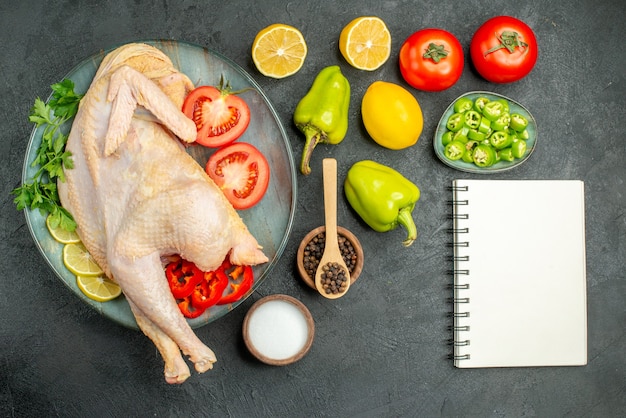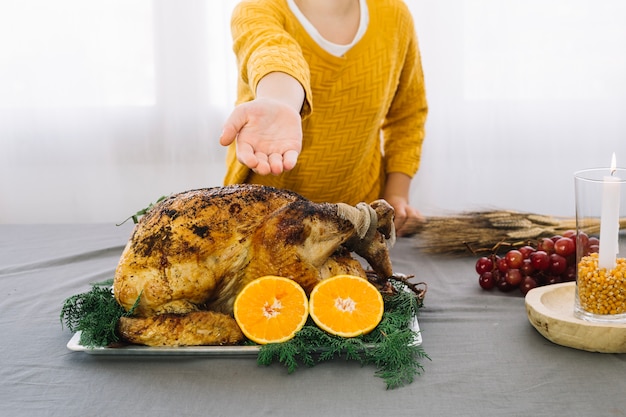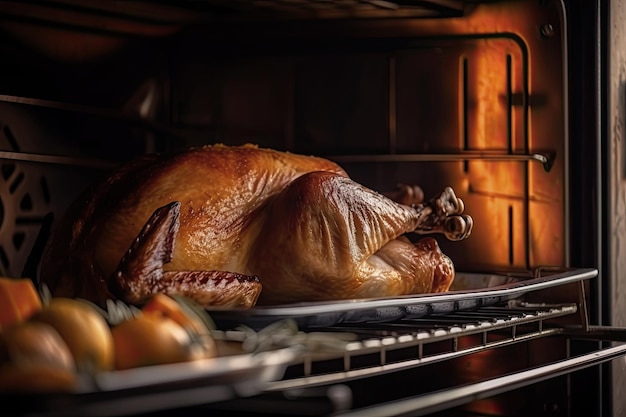Let's be honest, who doesn't love a good roast chicken? It's a culinary classic, a comforting dish that brings people together around the table. But achieving that picture-perfect golden-brown skin with juicy, tender meat inside? That's a whole other story. Believe me, I've been there! I've had my fair share of dry, rubbery chicken disasters, but I've also experienced those glorious moments when the chicken is so incredibly delicious, it feels like I've won the culinary lottery. Over time, I've learned a thing or two about the art of cooking the perfect chicken, and I'm excited to share my secrets with you. So grab your trusty oven thermometer, let's get cooking!
Part 1: Understanding Chicken Anatomy

Before we even delve into temperatures, we need to understand what we're working with. Think of a chicken like a puzzle, and we're trying to fit all the pieces together perfectly for a harmonious outcome.
Decoding the Chicken: A culinary journey
Let's dissect this culinary masterpiece! We've got the breast, the largest and leanest part, which is known for its delicate flavour. Then there's the thigh, the dark meat hero, known for its robust flavour and juiciness. And finally, we have the wings, those little bundles of flavour that add a special touch to any dish.
Temperature Variations: A Chicken's Tale
Every part of the chicken has its own temperature preferences. The breast, being lean, cooks faster and requires a lower temperature. The thighs, on the other hand, are fattier, so they need a bit more heat and longer cooking time to reach their full potential.
internal temperature: The Golden Rule
Now, let's talk about the golden rule of chicken cooking: internal temperature. This is the real game-changer, folks. It's the only way to know for sure if your chicken is safe to eat. The USDA recommends an internal temperature of 165°F (74°C) for all poultry, including our beloved chicken.
Part 2: Choosing Your Chicken: The Perfect Match

Now that we've got the basics down, let's talk about the star of the show – the chicken itself. Choosing the right chicken is essential, and it all comes down to personal preference. Do you prefer organic, free-range, or good ol' regular? Do you fancy a whole chicken or would you rather work with chicken parts?
Whole Chicken vs. Chicken Parts: A Culinary Debate
There's no right or wrong answer here. A whole chicken is a classic choice, perfect for roasting and creating a truly impressive centerpiece for your dinner table. Chicken parts, on the other hand, offer more flexibility in cooking methods and are great for quick weeknight meals. chicken breasts and thighs are particularly versatile and can be cooked in a variety of ways.
Size Matters: The Chicken's Weight
The size of your chicken will directly impact the cooking time. A smaller chicken will cook faster than a larger one. If you're unsure about what size chicken to buy, don't hesitate to ask your butcher for guidance.
Part 3: Preparing the Chicken: A Culinary Transformation

Okay, you've got your chicken, now it's time to get it ready for its culinary transformation. This is where the fun begins, but it's also crucial for achieving that perfect result.
Pat It Dry: A Moisture-Free Zone
Before you start seasoning, make sure you pat the chicken dry with paper towels. This will help the skin to crisp up beautifully while roasting.
Seasoning: A Symphony of Flavours
Now comes the fun part - seasoning! I'm a big fan of a simple salt and pepper rub, but the possibilities are endless. Get creative with herbs like rosemary, thyme, or oregano. Or, go bold with a blend of spices like paprika, cumin, and garlic powder.
The Art of Brining: Unlocking Juiciness
If you want extra juicy chicken, try brining it. This involves soaking the chicken in a salt water solution for several hours, which helps to retain moisture. It's like a spa treatment for your chicken, leaving it plump and hydrated. Just make sure you pat the chicken dry again after brining.
Part 4: Cooking Methods: Choosing Your culinary adventure
We've talked about the chicken itself, now let's discuss how we're going to cook it. There are several cooking methods, each with its own unique advantages, ready to take your culinary journey to the next level.
Roasting: The Classic Method
Roasting is the classic way to cook a whole chicken. It's simple, foolproof, and produces incredibly juicy, flavorful results. To roast a chicken, preheat your oven to 400°F (200°C). Place the chicken in a roasting pan and cook for about 1 hour and 15 minutes, or until the internal temperature reaches 165°F (74°C).
Pan-Frying: Quick and Easy
Pan-frying is a fantastic option if you're short on time. It's perfect for chicken breasts or thighs and produces a crispy, flavorful crust. Heat a skillet over medium-high heat and add a tablespoon of oil. Cook the chicken for 3-4 minutes per side, or until golden brown and cooked through.
Grilling: Embracing Smoky Flavours
Grilling is a great way to add a smoky flavour to your chicken. Pre-heat your grill to medium-high heat and cook the chicken for about 5-7 minutes per side, or until cooked through.
Baking: Perfect for Chicken Parts
Baking is a fantastic way to cook chicken parts like drumsticks or wings. Preheat your oven to 350°F (175°C). Place the chicken parts in a baking dish and cook for 20-25 minutes, or until cooked through.
Part 5: Monitoring the Temperature: The Key to Success
Now we get to the heart of the matter - temperature control. This is where the magic happens, folks. It's the difference between a dry, overcooked chicken and a juicy, delicious one.
Oven Thermometer: Your Culinary Companion
I can't stress this enough: an oven thermometer is your best friend when cooking chicken. It ensures your oven is at the correct temperature, which is crucial for even cooking.
meat thermometer: The Ultimate Guide
But even with a reliable oven, you still need to check the internal temperature of the chicken to ensure it's cooked through. This is where a meat thermometer comes in handy. It's your ultimate guide to achieving perfectly cooked chicken.
Don't Overcook: The Art of Timing
Keep in mind that once the chicken reaches the safe internal temperature of 165°F (74°C), it's done. Don't overcook it, or it will become dry and tough.
Part 6: Resting Time: Letting the Flavours Settle
Once the chicken is cooked, don't be tempted to carve it right away. Let it rest for 10-15 minutes before carving. This allows the juices to redistribute throughout the meat, resulting in a more tender and flavorful chicken.
Cover It Up: Preserving Moisture
While the chicken is resting, cover it with aluminum foil. This will help to keep it warm and moist.
Patience is Key: A Culinary Pause
It might be tempting to dig in right away, but trust me, the wait is worth it. The resting time is crucial for achieving that perfect chicken.
Part 7: The Ultimate chicken cooking chart: Your Culinary Guide
To make things even easier, I've created a table with the perfect cooking temperatures and times for different types of chicken. This is a great starting point, but remember to adjust the cooking time based on your oven and the size of the chicken.
| Type of Chicken | Cooking Temperature (°F) | Cooking Time |
|---|---|---|
| Whole Chicken | 400°F (200°C) | 1 hour 15 minutes - 1 hour 30 minutes |
| Chicken Breasts | 375°F (190°C) | 20-25 minutes |
| chicken thighs | 400°F (200°C) | 30-40 minutes |
| chicken drumsticks | 375°F (190°C) | 30-40 minutes |
| chicken wings | 400°F (200°C) | 30-40 minutes |
Part 8: Troubleshooting Common Chicken Cooking Problems: A Culinary Guide
Even with the best intentions, things can go wrong in the kitchen. Don't worry, I've got you covered. Here are some common chicken cooking problems and their solutions.
Dry Chicken: Reviving a Culinary Mishap
If your chicken is dry, it's likely because it was overcooked. To prevent this, use a meat thermometer to check the internal temperature, and don't overcook it. If your chicken is already dry, there's not much you can do, but you can try adding a sauce or gravy to help moisten it.
undercooked chicken: Prioritising Safety
If you're unsure about the chicken's doneness, always err on the side of caution and cook it for a few more minutes. Undercooked chicken can be dangerous, so it's best to be safe than sorry.
Unevenly Cooked Chicken: Achieving Culinary Harmony
If your chicken is unevenly cooked, it's likely because it wasn't placed in the oven correctly. Make sure the chicken is evenly spread out in the roasting pan, and that there's no overcrowding.
Part 9: Chicken cooking tips and Tricks: Mastering the Art
Now that you've got the basics down, let's talk about some tips and tricks to take your chicken cooking to the next level.
Don't Overcrowd the Oven: Giving Chicken Space
If you're cooking more than one chicken, make sure there's enough space between them. Overcrowding will cause the chicken to steam rather than roast, resulting in a soggy, undercooked chicken.
Basting for Extra Juiciness: A Culinary Secret
For an extra-juicy chicken, try basting it with pan drippings or butter while it's roasting. This helps to keep the chicken moist and flavorful.
roasting time: A Rule of Thumb
To avoid undercooked chicken, particularly when dealing with larger birds, use a simple rule of thumb: allow 20 minutes of cooking time per pound for a whole chicken. For instance, a 4-pound chicken would need about 80 minutes of roasting time.
Part 10: FAQs: Answering Your Culinary Questions
Here are some frequently asked questions about chicken cooking:
1. What is the best way to cook chicken?
The best way to cook chicken depends on your preference and what you're making. Roasting is a classic method that produces a juicy, flavorful chicken. Pan-frying is a quick and easy option for chicken breasts or thighs. Grilling adds a smoky flavor, while baking is perfect for chicken parts.
2. How do I know if chicken is cooked through?
The best way to know if chicken is cooked through is to use a meat thermometer. The safe internal temperature for all poultry is 165°F (74°C).
3. How long should I cook chicken?
The cooking time for chicken depends on the size and type of chicken you're cooking. The table above provides a general guideline for cooking times, but you should always use a meat thermometer to check the internal temperature.
4. What should I do with leftover chicken?
Leftover chicken can be used in a variety of dishes. You can make chicken salad, chicken soup, or add it to pasta or rice dishes. It can also be reheated and served with a side of vegetables.
5. Can I freeze chicken?
Yes, you can freeze chicken. To freeze chicken, wrap it tightly in plastic wrap or aluminum foil and place it in a freezer-safe bag. frozen chicken can be stored in the freezer for up to 2-3 months.
And there you have it, folks. The secrets to cooking the perfect chicken, revealed. Remember, practice makes perfect, so don't be afraid to experiment and find what works best for you. Happy cooking!
Everyone is watching

How to Cook Frozen Lobster Tails Perfectly: A Step-by-Step Guide
RecipesLobster. Just the word conjures up images of lavish meals, special occasions, and a taste of luxury. But let's...

Pork Fillet Cooking Time: How Long to Cook It Perfectly
RecipesPork fillet, or tenderloin as it's sometimes called, is a real favourite in our house. It's so versatile, and...

Pigs in a Blanket Cooking Time: How Long to Bake for Perfect Results
RecipesAh, pigs in a blanket. Just the name conjures up images of those delightful little parcels of crispy pastry en...

The Ultimate Guide to Cooking Delicious Frankfurters
RecipesLet's face it, we all love a good frankfurter. It's a classic, simple, and always satisfying. But let's be rea...

Wolf Meat Recipes: A Guide to Cooking Wild Game
RecipesLet's be honest, you don't see wolf meat at your local butcher shop every day. It's a bit of a wild card, but ...
